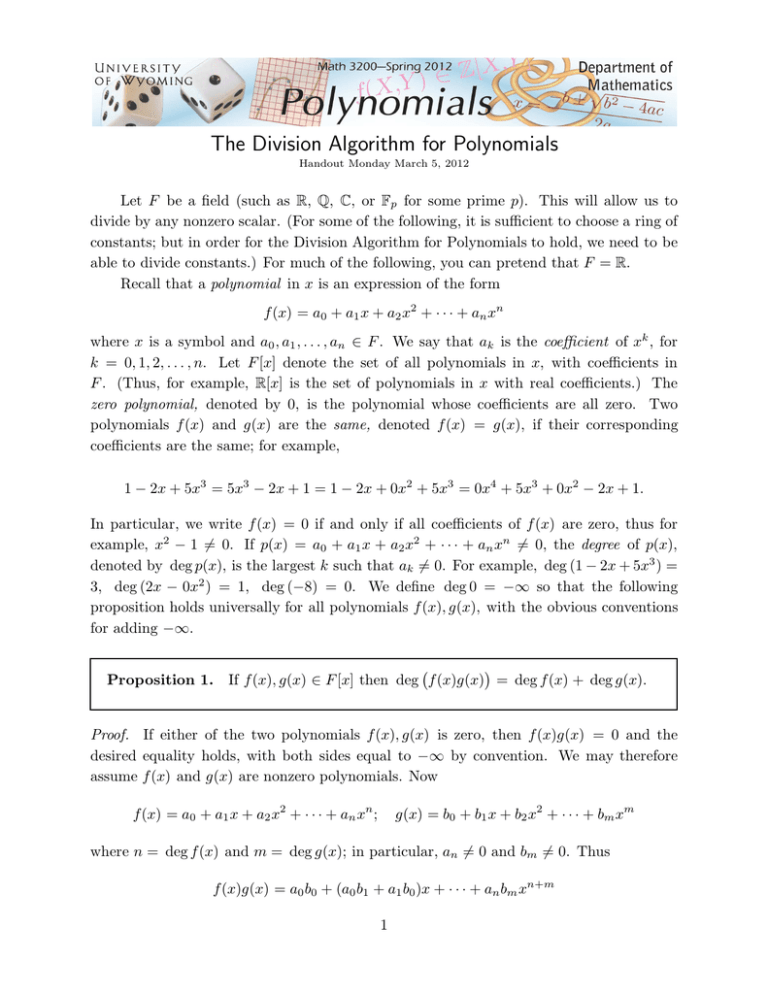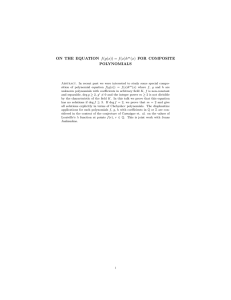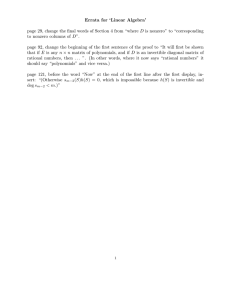The Division Algorithm for Polynomials
advertisement

The Division Algorithm for Polynomials
Handout Monday March 5, 2012
Let F be a field (such as R, Q, C, or Fp for some prime p). This will allow us to
divide by any nonzero scalar. (For some of the following, it is sufficient to choose a ring of
constants; but in order for the Division Algorithm for Polynomials to hold, we need to be
able to divide constants.) For much of the following, you can pretend that F = R.
Recall that a polynomial in x is an expression of the form
f(x) = a0 + a1 x + a2 x2 + · · · + an xn
where x is a symbol and a0 , a1 , . . . , an ∈ F . We say that ak is the coefficient of xk , for
k = 0, 1, 2, . . . , n. Let F [x] denote the set of all polynomials in x, with coefficients in
F . (Thus, for example, R[x] is the set of polynomials in x with real coefficients.) The
zero polynomial, denoted by 0, is the polynomial whose coefficients are all zero. Two
polynomials f(x) and g(x) are the same, denoted f(x) = g(x), if their corresponding
coefficients are the same; for example,
1 − 2x + 5x3 = 5x3 − 2x + 1 = 1 − 2x + 0x2 + 5x3 = 0x4 + 5x3 + 0x2 − 2x + 1.
In particular, we write f(x) = 0 if and only if all coefficients of f(x) are zero, thus for
example, x2 − 1 6= 0. If p(x) = a0 + a1 x + a2 x2 + · · · + an xn 6= 0, the degree of p(x),
denoted by deg p(x), is the largest k such that ak 6= 0. For example, deg (1 − 2x + 5x3 ) =
3, deg (2x − 0x2 ) = 1, deg (−8) = 0. We define deg 0 = −∞ so that the following
proposition holds universally for all polynomials f(x), g(x), with the obvious conventions
for adding −∞.
Proposition 1. If f(x), g(x) ∈ F [x] then deg f(x)g(x) = deg f(x) + deg g(x).
Proof. If either of the two polynomials f(x), g(x) is zero, then f(x)g(x) = 0 and the
desired equality holds, with both sides equal to −∞ by convention. We may therefore
assume f(x) and g(x) are nonzero polynomials. Now
f(x) = a0 + a1 x + a2 x2 + · · · + an xn ;
g(x) = b0 + b1 x + b2 x2 + · · · + bm xm
where n = deg f(x) and m = deg g(x); in particular, an 6= 0 and bm 6= 0. Thus
f(x)g(x) = a0 b0 + (a0 b1 + a1 b0 )x + · · · + an bm xn+m
1
where the last term is the unique term of highest degree in f(x)g(x), with coefficient
an bm 6= 0; thus
deg f(x)g(x) = n + m = deg f(x) + deg g(x).
We say that f(x) divides g(x) in F [x], denoted f(x) g(x), if g(x) = m(x)f(x) for
some m(x) ∈ F [x]. The following is obviously analogous to the Division Algorithm for
Integers. We omit the proof, which we take to be evident from the usual algorithm of long
division.
Theorem 2 (Division Algorithm for Polynomials). Let f(x), d(x) ∈ F [x] such
that d(x) 6= 0. Then there exist unique polynomials q(x), r(x) ∈ F [x] such that
f(x) = q(x)d(x) + r(x),
deg r(x) < deg d(x) .
As usual ‘unique’ means that there is only one pair of polynomials (q(x), r(x)) satisfying the
conclusions of the theorem. We call q(x) and r(x) the quotient and remainder, respectively.
Note that a(x) b(x) if and only if r(x) = 0. Note that the Division Algorithm holds in
F [x] for any field F ; it does not hold in Z[x], the set of polynomials in x with integer
coefficients.
A zero or root of f(x) is a number a such that f(a) = 0. An important consequence
of the Division Algorithm is the fact (made explicit by the following theorem) that roots
of polynomials correspond to linear factors.
Theorem 3.
Let f(x) ∈ F [x] and a ∈ F . Then f(a) = 0 if and only if (x − a) f(x).
Proof. If (x − a) f(x) then f(x) = (x − a)m(x) for some m(x) ∈ F [x], and so f(a) =
0m(a) = 0.
Conversely, suppose f(a) = 0. By the Division Algorithm, we may write f(x) =
(x − a)q(x) + r(x) for some q(x), r(x) ∈ F [x] where r(x) has degree less than 1 (the degree
of x − a). If r(x) = 0 then we would have (x − a) f(x), and so we would be done. So
let’s assume instead that r(x) 6= 0, in which case deg r(x) = 0, so r = r(x) is a nonzero
constant. Substituting a for x gives 0 = f(a) = 0m(a) + r, so r = 0. This contradiction
proves that in fact (x − a) f(x).
This argument extends to multiple roots:
2
Theorem 4. If f(x) ∈ F [x] has distinct roots a1 , a2 , . . . , an , then f(x) is divisible
by (x − a1 )(x − a2 ) · · · (x − an ). In particular, either f(x) 6= 0 or deg f(x) ≥ n.
Proof. Suppose f(x) has at least n distinct roots a1 , a2 , . . . , an . By Theorem 3, we have
f(x) = (x − a1 )g(x) for some g(x) ∈ F [x]. Substituting a2 for x gives 0 = f(a2 ) =
(a2 − a1 )g(a2 ) where a2 − a1 6= 0 since the n roots are distinct. Therefore g(a2 ) = 0,
and by Theorem 3 we have g(x) = (x − a2 )h(x) for some h(x) ∈ F [x]. Thus f(x) =
(x − a1 )(x − a2 )h(x). Continuing in this way, we eventually obtain f(x) = (x − a1 )(x −
a2 )(x − a3 ) · · · (x − an )m(x) for some m(x) ∈ F [x].
Corollary 5. A nonzero polynomial f(x) ∈ F [x] of degree n cannot have more than
n distinct roots.
The notion of gcd for integers, generalizes to polynomials as follows. Given two polynomials f(x), g(x) ∈ F [x], not both zero, we define the greatest common divisor (denoted
gcd(f(x), g(x)) to be the unique monic polynomial of highest degree dividing both f(x) and
g(x). Here ‘monic’ means ‘having leading coefficient 1’. Consider the following example:
The divisors of f(x) = 2x2 − 12 = 2 x + 21 x − 21 are all polynomials of the form
c;
c x+
1
2
;
c x−
1
2
;
c x+
1
2
x−
1
2
where c is an arbitrary nonzero constant. The divisors of g(x) = 2x2 − 3x + 1 = (2x −
1)(x − 1) = 2 x − 12 x − 1 are
c;
c x−
1
2
;
c x−1 ;
c x−
1
2
x−1
where c is an arbitrary nonzero constant. The common divisors of f(x) and g(x) have the
form
c; c x − 12
where c is an arbitrary nonzero constant. The polynomials of highest degree dividing both
f(x) and g(x) have the form c x − 12 where c is a nonzero constant. In order that the
greatest common divisor of f(x) and g(x) be well-defined, we choose c = 1 so that the
answer is monic; thus
gcd f(x), g(x) = gcd(2x2 −
1
2
, 2x2 − 3x + 1 = x −
1
2
.
The computation of gcd(f(x), g(x)) does not require knowing how to factorize polynomials; instead, we use Euclid’s Algorithm, just as we did with integers. This algorithm,
3
in its extended form, also expresses gcd(f(x), g(x)) as a ‘polynomial-linear combination’
of f(x) and g(x):
Theorem 6 (Euclid’s Algorithm for Polynomials). Let f(x), g(x) ∈ F [x] be
polynomials, not both zero. Then there exist polynomials r(x), s(x) ∈ F [x] such that
r(x)f(x) + s(x)g(x) = gcd f(x), g(x) .
For example, we compute the gcd of the polynomials f(x) = 5x3 + 2x2 + 3x − 10, g(x) =
x3 + 2x2 − 5x + 2 ∈ Q[x]. The steps are almost the same as when computing the gcd of
two integers. We proceed to repeatedly apply the Division Algorithm:
f(x) = 5g(x) + (−8x2 + 28x − 20)
11
g(x) = − 18 x − 16
(−8x2 + 28x − 20) +
4
47
−8x2 + 28x − 20 = 47
−8x + 20 47
4 x− 4 +0
47
4 x
−
47
4
47
47
At this point we might want to say that gcd(f(x), g(x)) = 47
4 x − 4 = 4 (x − 1) (the
last nonzero remainder). However observe that the much simpler polynomial x − 1 divides
both f(x) and g(x). We choose the gcd to be monic, i.e. its leading coefficient should be 1.
So in this case gcd(f(x), g(x)) = x − 1 and the extended form of the algorithm allows us
to write this as a polynomial-linear combination of f(x) and g(x):
(−8x2 + 28x − 20);
4
1
11
x − 1 = 47
g(x) + 94
x + 188
(−8x2 + 28x − 20)
4
1
11
= 47
g(x) + 94
x + 188
f(x) − 5g(x)
1
11
5
39
= 94
x + 188
f(x) + − 94
x − 188
g(x).
47
4 x
−
47
4
= g(x) − − 81 x −
11
16
Ugly fractions like this are to be expected when working over Q. Life is much easier
working over Fp , when coefficients are more simply expressed as elements of {0, 1, 2, . . . ,
p−1}. Consider what happens to the preceding example over F7 :
f(x) = 5x3 + 2x2 + 3x + 4,
g(x) = x3 + 2x2 + 2x + 2;
f(x) = 5g(x) + (6x2 + 1)
g(x) = (6x + 5)(6x2 + 1) + (3x + 4)
6x2 + 1 = 5(6x + 1)(3x + 4) + 0
4
so from 3x + 4 = 3(x + 6) we obtain gcd(f(x), g(x)) = x + 6 over F7 . The extended version
of Euclid’s Algorithm over F7 is also not hard:
3x + 4 = 3(x + 6) = g(x) − (6x + 5)(6x2 + 1);
x + 6 = 5g(x) + (5x + 3)(6x2 + 1)
= 5g(x) + (5x + 3)(f(x) − 5g(x))
= (5x + 3)f(x) + (3x + 4)g(x).
It is important to understand how this works (and to be prepared to perform simpler
versions of this on a test) in the same way that we expect you to be able (in principle)
to perform arithmetic (including multiplication and division of large integers). However,
there is no additional benefit in repeatedly performing such operations by hand once the
principles are mastered. For this we may use Maple:
The analog of prime numbers, for polynomials, is the concept of an irreducible polynomial . A polynomial p(x) ∈ F [x] of degree ≥ 1 is irreducible if its only divisors are c and
cp(x) where c is a nonzero constant. The concept of irreducibility depends on the choice
of field F ; for example, x2 − 2 is irreducible over Q, but not over R where it factors as
5
√ √ x + 2 x − 2 . The polynomial x2 + 1 is irreducible over Q and over R, but not over
√
C where it factors as (x + i)(x − i), i = −1. Recall Euclid’s Lemma for Integers, which
states that a prime p divides a product of two integers ab, iff p a or p b. (As usual, this
is an inclusive ‘or’: we allow the possibility that both a and b are divisible by p.) This fact
extends to polynomials, with the same proof.
Theorem 7 (Euclid’s Lemma). Let p(x) ∈ F [x] be irreducible, and consider two
polynomials f(x), g(x) ∈ F [x]. If f(x)g(x) is divisible by p(x), then p(x) f(x) or
p(x) g(x).
Proof. Suppose that p(x) 6 f(x); we must prove that p(x) g(x). Since p(x) 6 f(x)
where p(x) is irreducible, we have gcd(p(x), f(x)) = 1. By Euclid’s Algorithm, there exist
r(x), s(x) ∈ F [x] such that
1 = r(x)p(x) + s(x)f(x).
Then
g(x) = [g(x)r(x)]p(x) + s(x)[f(x)g(x)]
is divisible by p(x) as required.
A consequence of Euclid’s Lemma is the fact that every polynomial has an essentially
unique factorization into irreducible factors. By ‘essentially unique’, we mean the factorization is unique except for constant scalar multiples. If we factor out the coefficient of the
leading term, and then use only monic irreducible factors, then the factorization is unique.
This is the analogue (for polynomials) of the Fundamental Theorem of Arithmetic (the
fact that every positive integer has a unique factorization as a product of primes).
HOMEWORK #3 Due Mon March 19, 10:01 am
Solutions for this homework will be posted moments after the deadline, and further submissions will not be accepted beyond that time. Submit solutions in class, or to the
departmental office (the secretary will put them in my mailbox), or by sliding under my
office door, or by email. (Remember never to submit homework outside my door.) Solutions should be done by hand, but may be checked using Maple or other software (Sage,
etc.).
1. Show that there do not exist polynomials q(x), r(x) ∈ Z[x] such that x2 − 3x + 4 =
(3x + 1)q(x) + r(x) and r(x) is a constant. Conclude that the Division Algorithm does
not hold in Z[x].
6
2. Show that there do exist polynomials q(x), r(x) ∈ Q[x] such that x2 − 3x + 4 =
(3x + 1)q(x) + r(x) and r(x) is a constant. (This is an example of the Division
Algorithm in Q[x]. The Division Algorithm holds for F [x], where F is any field, such
as R, Q or Fp .)
3. Consider the polynomials f(x), d(x) ∈ F5 [x] given by
f(x) = x4 + 2x3 + 4x2 + x + 3;
d(x) = 2x2 + x + 3.
Find the quotient q(x) and remainder r(x) when f(x) is divided by d(x). Express
your answers for q(x) and r(x) in simplified form using coefficients 0, 1, 2, 3, 4.
4. Consider the polynomials f(x), g(x) ∈ F7 [x] given by
f(x) = x5 + x + 1;
g(x) = x4 + x2 + 1.
Determine gcd(f(x), g(x)) and find r(x), s(x) ∈ F7 [x] such that
r(x)f(x) + s(x)g(x) = gcd f(x), g(x) .
7





